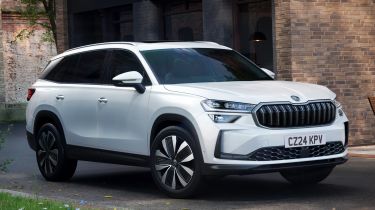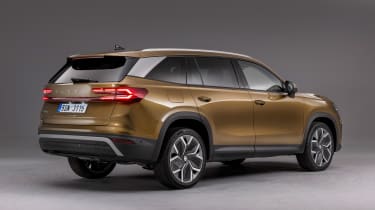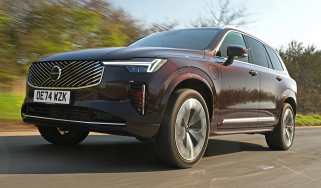All-new Skoda Kodiaq: prices, specs, plug-in hybrid option and full details
The Skoda Kodiaq enters its second generation with a plug-in powertrain for the first time
- More interior and boot space than before
- New plug-in hybrid powertrain
- Costs from £36,645
Following the full reveal of the new Skoda Kodiaq last October, details have been confirmed for the Skoda Kodiaq iV, the plug-in hybrid variant. Priced from just under £42,000, the Kodiaq iV will be up against other plug-in hybrid SUVs, such as the Mazda CX-60 and new Volkswagen Tiguan, when the first examples reach our roads later in 2024.
The plug-in hybrid will be sold alongside the regular petrol-powered Kodiaq, costing from £36,645. Both models offer the same large SUV package as before, but updated with new looks, engines and technology, and both are available to order now in the UK.
What do I need to know about the new Skoda Kodiaq?
The outgoing Kodiaq is no easy act to follow, picking up our Large Family Car of the Year award in 2023 and 2024. For the second-generation model, Skoda has stuck to the same formula as before but applied its latest ‘Modern Solid’ design language, intended to emphasise practicality while also improving aerodynamics. Inside has seen a big change, too, with a revised dashboard layout and a pair of new screens.
Arguably the biggest news, however, is that the Kodiaq is an even bigger car than before, growing 61mm in length. Skoda claims that this equates to more interior space for passengers, and more boot space as well. In five-seater versions, load capacity has grown by 75 litres to 910 litres, while in seven-seater cars, you get 340 litres of cargo space with all seven chairs in place, an improvement of 70 litres.
Earlier last year, we had the chance to drive a prototype of the new Skoda Kodiaq, which you can read at the end of this article.
What does the new Skoda Kodiaq look like?
In terms of styling, the second-generation Skoda Kodiaq doesn't represent a massive departure from the outgoing car, although there are subtle changes that bring the new car up-to-date and give it a smoother, cleaner look than before. The front end gets a restyled split headlight design, on par with the brand’s other cars, and the SUV gets an overall wider, more aggressive stance.
The rear of the car gets a more thorough rethink, with the rear-most side windows curving upwards towards the D-pillar and a metal-look panel joining it with the rear window, creating a ‘floating roof’ effect seen on other Volkswagen Group cars such as the Audi Q4 e-tron – Skoda says customers will be able to option this in a ‘Dark Chrome’ finish. The rear lights get a new C-shaped design united by a light bar spanning the width of the tailgate, and a sleek spoiler helps taper off the SUV’s silhouette at the top.
A while back Skoda teased the upcoming SUV’s side profile, featuring a strong LED headlight signature and rear light design that fades into the body. The new Kodiaq looks to be taking an evolutionary approach to its styling, merging existing design cues from the Skoda range with nods to the new ‘Modern Solid’ design language of the brand’s upcoming electric vehicles, including the mid-sized Skoda Elroq and a new even smaller SUV.
What’s new for the Skoda Kodiaq’s interior?
The new Kodiaq’s interior is less conservative in design than before, adopting a similar layout to the new Skoda Octavia and Skoda Superb. Skoda says the interior will make greater use of sustainable materials, with 100% recycled polyester, and eco leather tanned by coffee bean processing residues and wastewater from olive processing.
The gear selector has been relocated to the steering column to improve space on the centre console, allowing for more storage. Skoda is keen to draw attention to its Smart Dials: innovative physical knobs which can be configured to toggle through and adjust various settings with the same button, with small 32mm digital displays on each one which change depending on the function.
A new 13-inch infotainment screen also makes an appearance, as well as a 10-inch virtual cockpit ahead of the driver, ambient interior lighting, a phone box with wireless smartphone charging, plus USB-C ports found in the centre console and also near the rear-view mirror, making it easier to fit and charge a dashcam.
A wide variety of new driver assistance and safety systems have been added, and many of those available in the previous Kodiaq have undergone extensive operational upgrades. Up to nine airbags are available, too.
What engines are offered with the new Skoda Kodiaq?
A total of five powertrain options will be offered. Petrol options include a 1.5-litre TSI turbo mild-hybrid with 148bhp, and a 2.0-litre TSI with 201bhp. Two 2.0-litre diesels, meanwhile, will offer either 148bhp or 190bhp. All come with a seven-speed DSG dual-clutch automatic gearbox, while the more powerful petrol and diesel engines also get four-wheel drive.
The biggest news on the powertrain front, however, is the new plug-in hybrid variant, known as the Kodiaq iV. It teams the 1.5-litre petrol engine with a 114bhp electric motor, delivering a combined output of 201bhp to the front wheels via a six-speed DSG automatic gearbox.
Thanks to a large 25.7kWh (19.7kWh usable) battery pack, Skoda claims that the Kodiaq iV will be able to travel up to 75 miles on electric power alone, giving it one of the longest electric-only driving ranges of any plug-in hybrid on the market. There’s DC charging compatibility up to speeds of 50kW, enabling a 10-80% recharge in around 26 minutes. Charge at home, and it’ll take around 2.5 hours at speeds of up to 11kW AC.
While the addition of a silent electric-only driving mode sounds appealing, the Skoda Kodiaq iV does come with some practicality sacrifices. The boot shrinks slightly, but at 745 litres, you’re unlikely to struggle. More significant is the lack of a seven-seat Kodiaq iV; the plug-in hybrid model is strictly for five passengers only, with the rearmost pair of folding seats presumably ditched to make room for the large battery.
While the Czech brand has pledged to go fully-electric by 2030, the new Kodiaq will not be offered with a fully-electric powertrain – making it one of the last combustion-engined Skodas likely to be developed. Those wanting an electric seven-seater will instead have to wait for the production version of the Skoda Vision 7S concept car, which will eventually sit alongside the Kodiaq in the brand’s lineup.
How much does the new Skoda Kodiaq cost and when can I order one?
At launch, Skoda will offer the Kodiaq in two trim levels – SE and SE L – while more expensive models are set to follow.
The entry-level SE model is available in either a five-seat or seven-seat configuration, the former starting from £36,645 with the 1.5-litre petrol engine. That’s a fairly hefty jump from the £27,650 base price of the Kodiaq after its 2021 facelift. Diesel models cost from £38,945, while upgrading from five to seven seats adds £860 to the bill. The plug-in hybrid Kodiaq iV starts from £41,935 in SE trim, however, it’s available exclusively as a five-seater.
SE L models fit seven passengers as standard and cost from £40,205 with the 1.5-litre petrol engine, while opting for the 148bhp or 190bhp diesel engine costs £42,505 and £46,225 respectively. The Kodiaq iV SE L will set you back £44,635.
UK customers can place an order now for both the new Kodiaq in petrol and diesel guise, and the plug-in hybrid Kodiaq iV.
Skoda Kodiaq prototype review – Alastair Crooks
We were recently given the opportunity to drive a late-stage prototype of the upcoming Skoda Kodiaq (still in camouflaged form) to find out how the family SUV is shaping up ahead of its full release expected later this year.
While the plug-in hybrid model is expected to arrive later in 2024, we got to drive the front-wheel drive mild-hybrid 1.5-litre petrol and 2.0-litre diesel versions.
Skoda expects the majority of sales for the Skoda Kodiaq will be the 1.5-litre petrol, so it’s the model we’ll be focusing on here. Perhaps unsurprisingly, given they sit on the same platform, we found the latest Skoda Kodiaq to feel very similar to drive as the outgoing model. That’s no bad thing – the engine feels capable and the seven-speed dual-clutch gearbox is smooth and quick.
Despite the Kodiaq’s size, we were surprised at how composed it felt through corners, although there’s little to no feel through the steering. That said, the steering does at least feel well-weighted.
Our test car sat on 19-inch wheels and offered a satisfactory ride, and with wind and road noise kept well at bay thanks to the Kodiaq’s double-glazed windows, it felt reasonably refined. On rougher roads, however, the ride wasn’t so good, and the suspension setup felt like it could do with softer springs. While the production model will likely get a choice of drive modes, our test car was limited to just ‘Normal’, so it’s likely the final version will allow for greater tweaking of the ride and performance.
Skoda is famed for its practicality, and the upcoming Kodiaq looks set to be slightly longer than before with a larger 910-litre boot compared with the outgoing car’s 835 litres.
Impressively, even with a third row of seats in place on seven-seater versions, there’s still up to 845 litres of boot space in the new Kodiaq. Kneeroom seems impressive even with the middle row seats slid forward, and with them raked all the way back it feels incredibly spacious. Headroom for third-row occupants is now more generous, having increased by 15mm.
There are other practical touches dotted around the cabin, too, such as two litres of storage in the centre console freed up by a smaller gear selector, and an extra rear storage compartment. Other interior features include dual smartphone charging, and a touchscreen wiper to clean smudges on the display.
The Kodiaq is set to get a generous suite of safety tech – we got to try the car’s automatic brake assist function but found it to be quite intrusive. The brand has assured us it’s still under development, however.
Verdict
It looks as though Skoda isn’t trying to reinvent the wheel with the upcoming Kodiaq, but there’s nothing wrong with taking all of the best attributes of the outgoing car and building on them. There are some nice touches around the cabin that prove to further Skoda’s ‘Simply Clever’ ethos and focus on practicality. If we have any major criticisms it would be the car’s ride, which we hope will be optimised for improved comfort by the time the new Kodiaq hits showrooms.
Find out more about the upcoming Skoda Epiq, a small electric SUV arriving in 2025…
Recommended

New giant Skoda EV coming next year to challenge the Kia EV9
Most Popular

Omoda E5 targets rivals: now with zero deposit and APR
Tips & advice

Car dashboard warning lights: what does each symbol mean?

Electric car charging stations: public networks, charger types, apps and maps

















